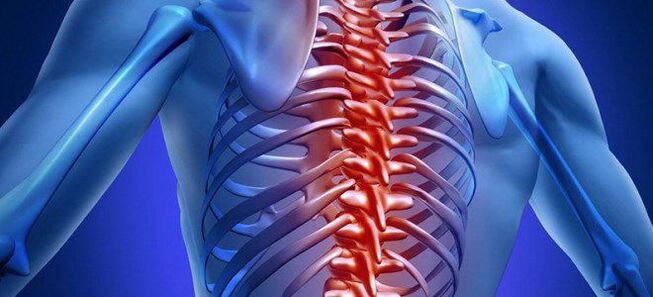
Recently, doctors have received more and more complaints about back pain, and often young women suffer from them. If the discomfort is localized in the thoracic spine, then it may be caused by a disease such as thoracic osteochondrosis, the symptoms of which are described in detail below.
Thoracic osteochondrosis - causes
Spinal osteochondrosis is a pathology in which negative modifications occur in the tissues of the intervertebral discs - elements of the spine located between two vertebral bodies. The intervertebral disc is a type of round flat cushion composed of a gel-like collagen core, fibrous connective cartilage and vitreous. The main functions provided by these structures are:
- connection and maintenance of adjacent bodies of vertebral bones;
- spine shock absorption protection, protecting against damage due to body gravity and loads;
- ensuring the mobility of adjacent vertebrae in relation to each other.
If the intervertebral discs are in satisfactory functional condition, the spine is equipped with elasticity, mobility and the ability to withstand various mechanical loads. When the cartilage structure changes shape, structure, loses strength and elasticity, these functions cannot be fully performed. Basically, this happens against the background of metabolic disorders.

In part, the pathological changes in the intervertebral discs that cause thoracic osteochondrosis are explained by the fact that with age their nutrition through blood vessels stops, and the supply of nutrients becomes possible only due to the neighboring structures (ligaments, vertebral bodies). The exact causes of poor nutrition of the intervertebral structures and the mechanism of their destruction are not known, but doctors identify a number of predisposing factors:
- systemic metabolic disorders in the body;
- excess body weight;
- poor nutrition, drinking regime;
- passivity;
- sedentary work;
- poor posture;
- flat feet;
- back injury, back;
- intense physical work or sports training;
- pregnancy;
- wearing uncomfortable shoes, high heels.
Degrees of thoracic osteochondrosis
A disease such as thoracic osteochondrosis does not show symptoms immediately, because it develops gradually and over a long period of time. In addition, due to the low mobility of the spine in this area, osteochondrosis of the thoracic region manifests itself in the later stages, in the presence of significant pathological changes. In total, four degrees of pathology are distinguished, depending on the deviations developed.
Thoracic osteochondrosis of the first degree
The preclinical stage is grade 1 osteochondrosis of the thoracic spine. At this stage, partial dehydration and compression of the central part of the intervertebral discs occurs, their height decreases, which leads to a decrease in their elasticity and stability. The ability of the spine to withstand ordinary loads is still preserved. Disc protrusions begin to form.
Thoracic osteochondrosis of the second degree
When grade 2 thoracic osteochondrosis develops, the disease is characterized by the appearance of cracks in the fibrous ring. The decrease (thinning) of the discs continues, the amount of intervertebral fluid decreases significantly and the vertebrae begin to rub against each other, while the load on the back increases. This stage is sometimes called discogenic radiculitis.

Thoracic osteochondrosis of the third degree
Osteochondrosis of the thoracic spine of the 3rd degree is accompanied by destruction and rupture of the fibrous tissue of the disc, release of the nuclear part, d. m. th. the formation of a hernial protrusion of the intervertebral disc occurs. As a result, the nerve roots begin to be pressed, the nearby vessels are compressed and the veins and arteries are constricted.
Thoracic osteochondrosis 4 degrees
The last, most severe stage of the disease is characterized by displacement, twisting, deformation of the vertebral bodies, a further increase in their area and spread. The affected fibrous disc tissue begins to be replaced by bone tissue in the form of specific growths - osteophytes, compressing the spinal cord. As a result, the mobility of the spine is significantly reduced.
Osteochondrosis of the thoracic spine - symptoms
Due to the peculiarities of localization of pathological processes, osteochondrosis of the chest region has typical and atypical symptoms, repeating the manifestations of other diseases. This is due to the fact that due to compression of blood vessels and nerve fibers, structural changes in the spine, the functions of nearby internal organs are interrupted.
Let's list which symptoms of thoracic osteochondrosis are characteristic and most common:
- back and chest pain;
- feeling of squeezing in the chest;
- tingling sensation in limbs;
- numbness in arms, legs, neck, shoulders;
- stiffness, pain in the back and limbs;
- muscle spasm in the upper and middle back;
- limited mobility of the spine in this area (difficulty in bending the body).
Pain due to osteochondrosis of the thoracic spine
When diagnosed with "thoracic osteochondrosis", pain-related symptoms stand out among other complaints. Their intensity and duration depend on the stage of the pathological process. The localization of the pain can periodically change rapidly, for example, moving from one area of the chest to another, covering the entire chest. The pain is often felt in the area between the shoulder blades. The nature of pain in thoracic osteochondrosis is dull, compressive, sharp. Increased pain is observed at night and with:
- raising hands up;
- neck claws;
- carrying heavy objects;
- sudden movements;
- increased physical activity;
- strong breathing, coughing, sneezing;
- hypothermia.
Can there be shortness of breath with thoracic osteochondrosis?
Due to displacement of vertebral bodies, pathological changes in the structure of the chest, compression of nerve fibers and blood vessels connected to the lungs, shortness of breath often occurs with thoracic osteochondrosis. In addition, because in the thoracic region there are structures responsible for the innervation of the heart, intestines, liver, kidneys and some other organs; the disease in many cases is accompanied by the following symptoms:
- headache, dizziness;
- pain in the heart area;
- mammary gland pain;
- pain in the hypochondrium (similar to the appearance of pancreatitis, cholecystitis);
- epigastric pain not associated with eating;
- discomfort in the pharynx, esophagus, foreign body sensation;
- sexual dysfunctions.
Pain in the heart with osteochondrosis of the chest, often oppressive, constricting, can be misleading when making a diagnosis, because it is similar to the manifestations of angina pectoris, myocardial infarction. A feature of these sensations is their long duration and lack of effect when taking medications for the expansion of heart vessels. There are no changes in the cardiogram.

Thoracic osteochondrosis syndromes
Symptoms of thoracic osteochondrosis in women, associated with a single mechanism of occurrence, are present in many cases in a complex manner. There are two syndromes with a number of specific pathological conditions caused by thoracic osteochondrosis:
- dorsalgia;
- dorsago.
Dorsalgia of the thoracic spine
Prolonged, not very pronounced pain with thoracic osteochondrosis in women, often characterized as pain, pulling, is inherent in dorsalgia. Complaints may be present for 2-3 weeks, with discomfort either decreasing (especially when walking) or intensifying (often at night, when bending over or taking deep breaths). In the presence of this syndrome, thoracic osteochondrosis may also have symptoms associated with breathing difficulties and muscle stiffness.
Dorsago of the thoracic spine
Paroxysmal manifestations of the disease are called "dorsago" or "thoracic lumbago". In this case, the pain appears suddenly, acutely, often resembling signs of a heart attack. An attack of thoracic osteochondrosis has the following symptoms:
- sharp, dagger-like pains;
- pain is felt in the area between the ribs, the interscapular area;
- often an attack appears after a long stay in one position;
- the pain intensifies when the torso rotates;
- there is difficulty in breathing, severe muscle tension.
Osteochondrosis of the thoracic spine - consequences
If the treatment of the pathology is not started in time, osteochondrosis of the chest region can have the following consequences:
- vegetative-vascular dystonia;
- migraine;
- disruption of the functioning of internal organs (liver, kidneys, etc. );
- decreased hearing, vision;
- epicondyle of the elbow joint;
- paresis and paralysis of the arms;
- rachiocampsis;
- loss of skin tissue sensitivity;
- disability etc.

How to treat thoracic osteochondrosis?
If symptoms of thoracic osteochondrosis appear, it is recommended to consult a neurologist who, after examining the back and examining the spine in several positions of the patient, will be able to make a primary diagnosis. To determine the degree of damage, X-rays, magnetic resonance images or computed tomography are prescribed. Treatment tactics depend on the results obtained.
Often, the painful symptoms of thoracic osteochondrosis of the spine are eliminated by taking non-steroidal anti-inflammatory drugs. In case of deterioration, accompanied by severe pain, paravertebral blocks can be performed with anesthetic solution. In addition, the following medications may be prescribed as part of conservative therapy:
- muscle relaxants;
- chondroprotectors;
- corticosteroids etc.
To improve metabolic processes, eliminate muscle hypertonicity and prevent various complications, the following treatment methods are used:
- physiotherapy;
- massage;
- manual therapy;
- traction of the spine;
- physiotherapeutic procedures (laser, ultrasound, etc. ).
Surgical treatment is required if there is compression of the spinal cord by a fragment of the intervertebral disc. In this case, either laminotomy - excision of the vertebral arches, or discectomy - removal of a part of the intervertebral disc or its complete removal with the installation of a graft can be performed. In clinics with modern equipment, surgical procedures are performed using methods with low trauma through small incisions.

























